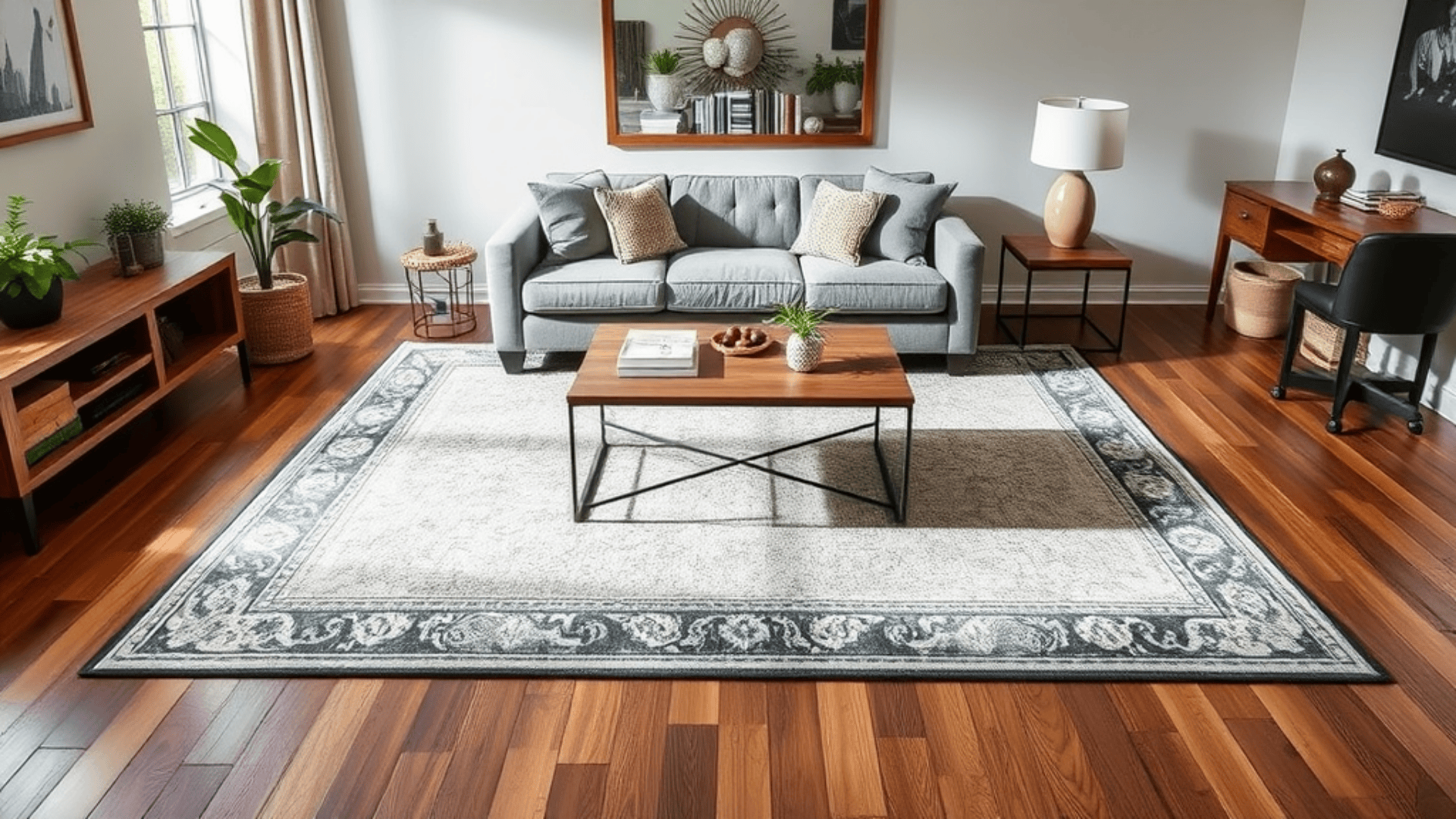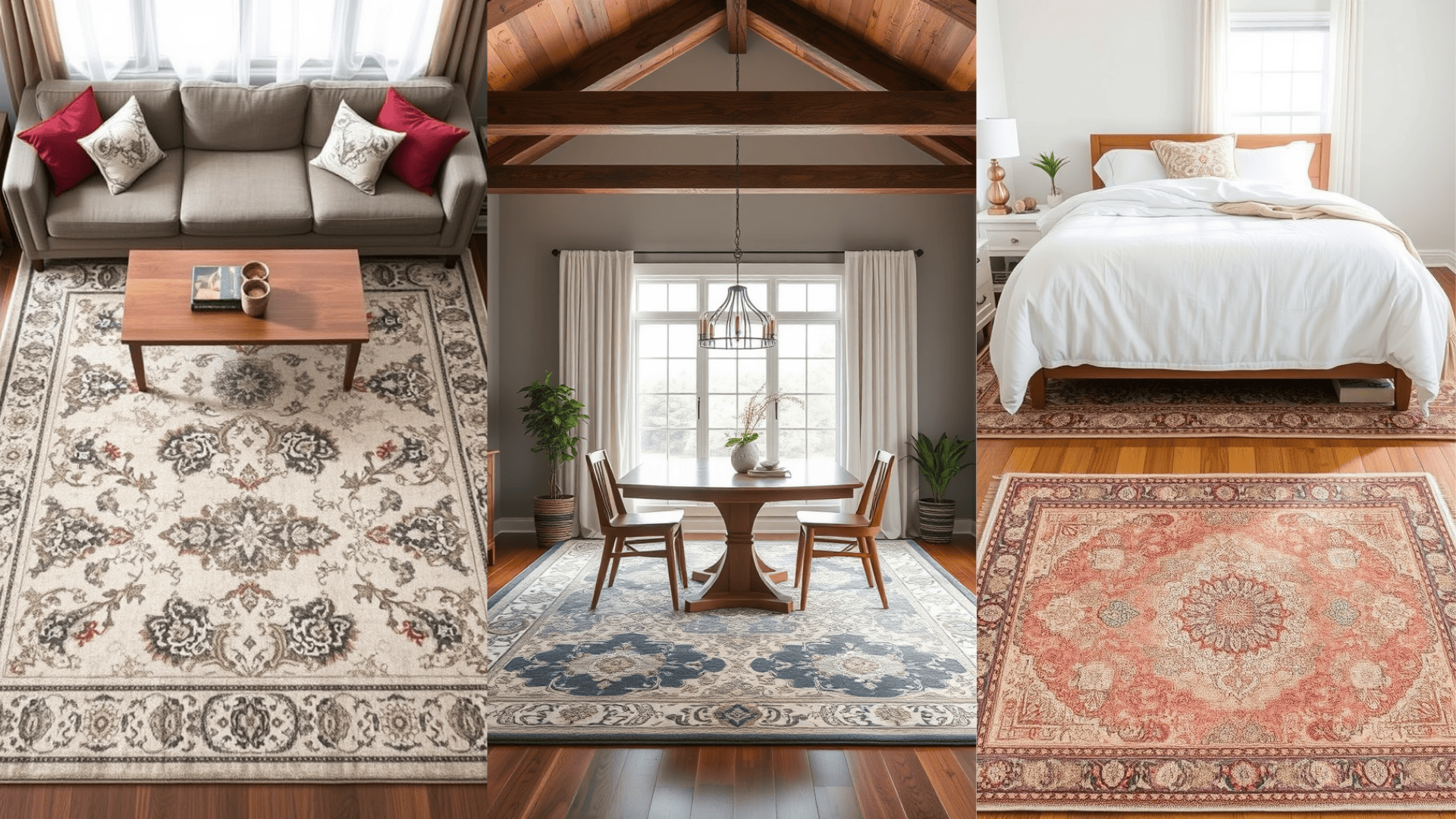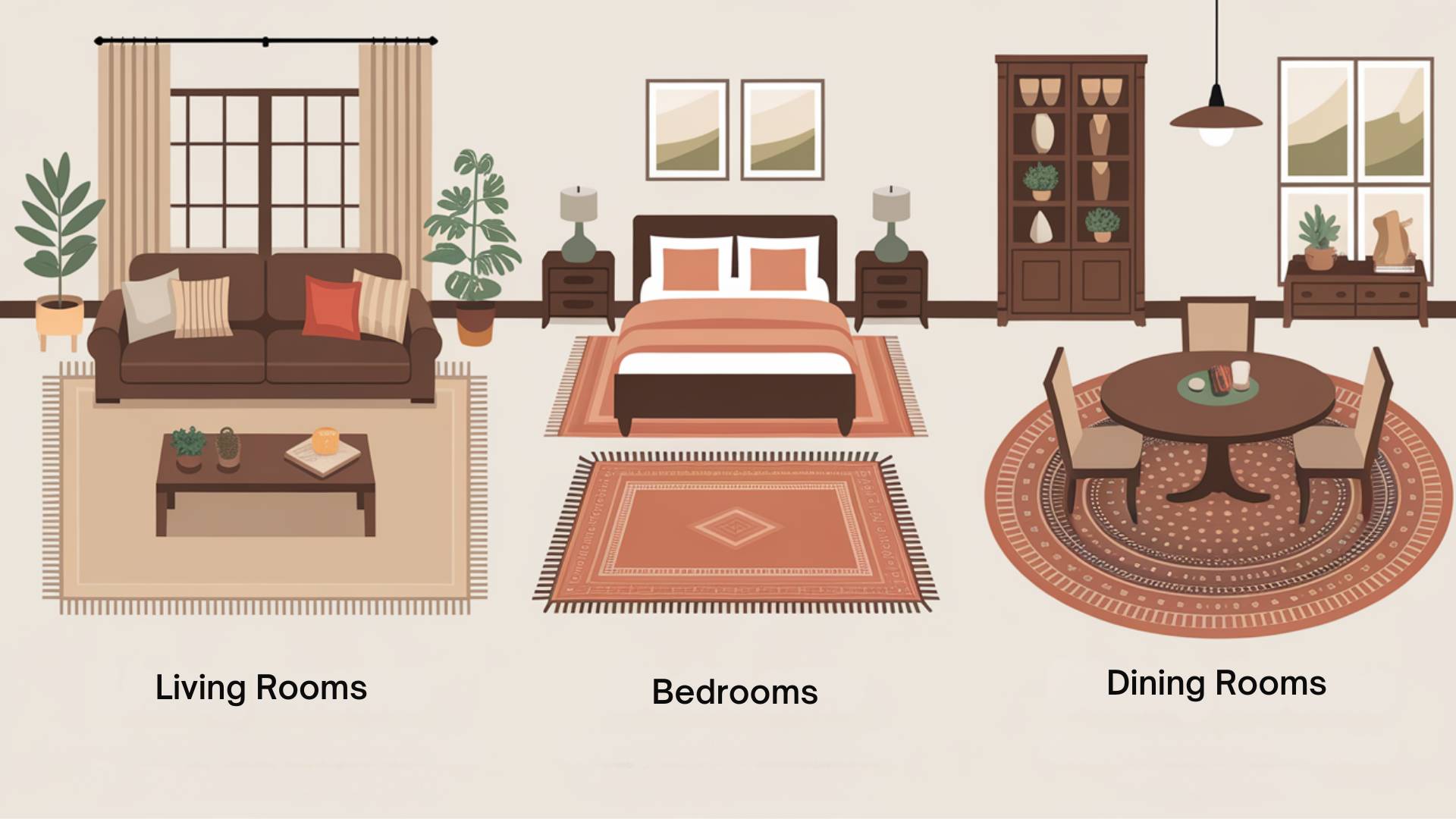Ever walked into a room and felt something was just… off? Chances are, it might be the rug.
Rugs are more than just floor coverings. They’re the secret weapon that can transform your space from bland to beautiful. But here’s the catch- placement is everything.
In this guide, we’ll walk you through the art of rug positioning. You’ll learn practical tips for choosing the right rug size, placing it perfectly in different rooms, and avoiding common mistakes.
Decorating a cozy bedroom, a welcoming living room, or a stylish dining area, we’ve got you covered.
Get ready to turn your floors into a stunning design statement that makes your home feel warm, inviting, and totally you.
Tips for Proper Rug Placement

The rug acts as a visual anchor in the room, just like a piece of art on a wall. It helps bring everything together by tying the furniture and architectural elements into one cohesive design.
Proper placement is important to ensure the rug balances the room, creating a sense of unity. It should frame the seating area or the room’s main features, helping to organize the space visually.
A well-placed rug can make the room feel grounded and complete, while an off-center or poorly placed rug can make the space unbalanced.
Placement Around Major Architectural Elements
Center the rug around key features like the fireplace, large windows, or TV console. The rug doesn’t always have to be in the center of the room, but it should be balanced around these focal points.
Aligning the rug with the room’s structure creates a more natural flow and ensures it enhances the space’s main elements.
Balance Under the Main Furniture Grouping
Ensure the rug covers the area beneath the main furniture pieces, like sofas or beds, to anchor the seating or sleeping arrangement.
Placing furniture on the rug helps create visual harmony. The furniture must be balanced to integrate the rug effectively and ground the space.
Furniture Leg Placement
All furniture legs should be on the rug, or at least the front legs, for a balanced look. This helps anchor the furniture and creates a cohesive feel in the room.
In bedrooms, the rug should be placed at the foot of the bed, allowing a warm and comfortable area to step onto when getting out of bed.
This placement adds both comfort and style while keeping the space visually grounded.
Experimenting with Angles and Orientation
Angling the rug can create a dynamic, interesting look while keeping the space functional.
The rug should frame the seating arrangement, helping to define the area and make it feel cozy. It should also balance the room’s focal points, like a fireplace or TV console.
Ensure the rug allows clear traffic paths around the furniture so the room feels easy to move through. Trying different angles can help you find the perfect arrangement that complements the room’s design and flow.
Choosing the Right Rug Size

To find the perfect rug size, start by measuring your space. Measure the length and width of the area where you want to place the rug, leaving a little extra space around the edges for balance.
Recommended Rug Sizes for Different Rooms.
- Living Room: 8×10 feet or 9×12 feet
- Bedroom: 5×8 feet for a small bed, 8×10 feet for a larger bed
- Dining Room: At least 8×10 feet, but larger for bigger tables
Tips for Balancing Rug Size.
- Avoid overcrowding the space with a rug that’s too big.
- A rug that’s too small can make the room feel disconnected.
- Ensure the rug leaves enough space around the furniture for the room to breathe.
Room-Specific Rug Placement

Rugs can transform a space, adding warmth, comfort, and style to your home. But getting the placement right can be tricky.
This section will walk you through exactly how to position rugs in different rooms to create a polished, inviting look.
Living Room: Creating a Cozy Seating Area
Choosing the right rug for your living room can tie the entire space together. For most seating areas, aim to place at least the front legs of your furniture on the rug.
Here’s a simple trick: measure your seating area and select a rug that’s large enough to anchor your furniture.
Ideal living room rug sizes:
- For a standard sofa (84 inches): Consider a 9×12 foot rug
- Smaller spaces: A 5×8 foot rug works well
- Tip: Leave about 18 inches of floor space around the rug’s edges
Bedroom: Softening Your Sleep Space
Your bedroom rug should make stepping out of bed feel like a warm hug. For full-size beds, you have two main options:
- Full room coverage: A large rug that extends under the entire bed
- Accent approach: Smaller rugs placed strategically beside the bed
King and queen beds look best with:
- Runner rugs on each side of the bed
- A large rug that extends 2-3 feet beyond the bed’s edges
Dining Room: Adding Comfort to Meal Times
Dining room rugs should extend well beyond your table. Here’s a simple rule: choose a rug that’s large enough for chairs to remain on the rug when pulled out.
Rug sizing guide:
- Rectangular tables: Rug should be 2 feet larger than the table on all sides
- Round tables: Choose a circular rug that’s wider than the table
- Measure carefully to avoid tripping hazards and ensure a clean look
Rug Materials and Their Impact on Placement
Choose materials that match your room’s style and aesthetic to create a cohesive, inviting space.
- Wool is durable and soft, making it great for high-traffic areas like living rooms. It’s also easy to clean and holds color well.
- Cotton is lightweight and breathable, perfect for casual settings like bedrooms or guest rooms. It’s easy to clean but may wear down faster.
- Jute is natural and eco-friendly. It is best for low-traffic areas like dining rooms. It adds texture but is harder to clean.
- Synthetics are affordable and durable, ideal for high-traffic areas or homes with pets and kids. It’s easy to clean and can mimic natural fibers.
Choosing a Material Based on Room Function: Consider foot traffic and maintenance needs when selecting your rug material. For high-traffic rooms, like living rooms, choose durable materials like wool or synthetic fibers. For bedrooms or low-traffic areas, cotton or jute works well.
How Material Types Influence Texture, Color, and Room Aesthetic: The material affects not only the look of the rug but also the feel and vibe of the room. Wool gives a luxurious texture, while jute offers a more rustic, earthy look.
How to Care for Your Area Rug
Vacuum your rug regularly to remove dirt and dust. Depending on the material, you may need to spot-clean it or take it to a professional cleaner.
If spills occur, quickly blot the area with a clean cloth—never rub it. For stains, use a mild detergent and warm water or a specialized rug cleaner.
High-traffic areas may need extra cleaning and attention to prevent wear and tear.
Rug pads help keep your rug in place, preventing slipping and bunching. They also add extra comfort underfoot and protect the floor from scratches, increasing the rug’s durability.
Common Mistakes to Avoid
Avoid Too-Small Rugs Under Coffee Tables.
Small rugs under a coffee table can look awkward and unbalanced. Therefore, it is important to choose a big enough rug to anchor the entire seating area.
Don’t Place Rugs Randomly.
Rugs should have a purpose and be placed intentionally. They should not be placed to fill empty spaces; they should be anchored in specific areas to tie the room together.
Limit the Use of Small Rugs.
Small rugs work best in functional areas like doorways, bathrooms, or kitchens. They should not be scattered throughout larger rooms as they can make the space feel messy and unorganized.
Conclusion
The right rug placement can improve your room’s design, creating a balanced and inviting space.
If you want to anchor your furniture, define areas within a room, or add warmth and style, the perfect rug can bring everything together.
Don’t be afraid to experiment with different rug sizes, placements, and angles to find what works best for your space.
Every room is unique, and sometimes, small changes can make a big impact.
If you’re looking for more home design tips and ideas, check out other blogs on our website for similar content to help you create the perfect space.
Frequently Asked Questions
What is the rule of thumb for area rugs?
The general rule is to have all front legs of the furniture on the rug, ensuring it’s large enough to anchor the furniture and tie the room together.
What is the 18-inch rule for rugs?
The 18-inch rule suggests leaving about 18 inches of space between the rug’s edges and walls, preventing the rug from looking cramped.
Where should a rug be placed in a living room?
In a living room, the rug should be placed under the main seating area, with at least the front legs of the furniture on it for balance.














